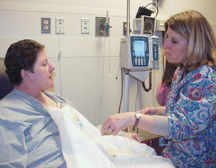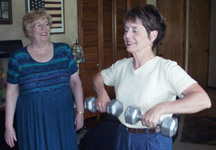The story behind the UNMC College of Nursing reaching new heights in federally funded research is one of strategy, vision, determination and teamwork. The college, which had no research funding from the National Institutes of Health a decade ago, ranks 21st in NIH research funding for schools of nursing in the most recent rankings.
“We are pleased with this jump in rank,” said Ada Lindsey, Ph.D., dean of the UNMC College of Nursing since 1995. “We had zero NIH funding when I came here and little major externally funded research.
 |
Diane Cox, nurse in the Lied Transplant Center, visits with Rhonda Schroeder, breast cancer patient, during a treatment. The study, funded by the NIH’s National Institute of Nursing Research, is being led by Ann Berger, Ph.D. |
“Gaining federal research dollars was one of my goals before I accepted the dean position and has been in our strategic plan,” she said. “To be ranked 21st is a real step up in the right direction for the college — moving into the national pool of better schools with active funded research programs.”
The college now has more than $8 million in NIH research funding, and is ranked among institutions with a much longer history of research productivity and with big-name universities such as Yale, Vanderbilt and Ohio State, which rank 13th, 14th and 19th, respectively. More than 600 nursing programs in the United States offer baccalaureate or higher degree programs; only 90 schools of nursing received NIH funding in fiscal year 2002, the year that was measured for these rankings.
It was only four years ago that the college began to make the rankings for NIH research dollars. The college was ranked 84th in fiscal year 2000 and 47th in 2001. The NIH is one of the world’s foremost medical research centers and funds medical and health care research. An agency of the Department of Health and Human Services, the NIH is the federal focal point for health research.
UNMC Chancellor Harold Maurer, M.D., is pleased with the college’s increased research and its high NIH ranking. One of his major priorities is research.
“This is spectacular!” Dr. Maurer said. “My hat is off to the faculty for becoming a research powerhouse among colleges of nursing in the United States. What a wonderful benefit to education and patient care.”
Dr. Lindsey said she may have been the driving force behind the research, but it was the faculty that did the work.
“I’ve facilitated and made it possible for others to succeed. The faculty have done a lot,” she said. “I set up a model for others. I did it purposefully to model behavior I want others to engage in.
“I personally met with the college’s research associate dean, department chairs and specific faculty to urge them to move research forward. It became part of our strategic plan, where individuals were held accountable for research productivity. All department chairs play a role, as well as assistant deans and individual faculty. I think they, too, are excited about the movement of our research program.”
She said another ingredient toward research success is having a doctoral program. The college’s doctoral program is about 11 years old. She explained doctoral degrees, though not required to obtain research funding, better prepare faculty to obtain and conduct research.
Research funding also provides more resources and recognition, helps recruit more and better faculty and students, and increases an institution’s national and international sphere of influence.
“If you’re in a university, you should be generating new knowledge,” Dr. Lindsey said. “Research is absolutely essential. It’s the major building block from which education and practice develop. Research sets a university apart from other higher learning institutions. “It takes a while to build research capacity.”
 |
Janice Twiss, Ph.D., UNMC associate professor of nursing (left) is co-investigator of a National Institute of Nursing Research study led by Nancy Waltman, Ph.D. Here, Dr. Twiss works with Linda Hitt, who participated in a pilot study that is now funded. |
The college also moved some faculty appointments from nine to 12 months so faculty could have more time to develop and work on research.
“Our focus on research really was a very extensive building structure trajectory,” Dr. Lindsey said.
Tactics used included mock reviews of grant proposals so faculty could strengthen their proposals before submitting them externally. College of Nursing researchers go through two reviews before they submit the grant proposal for funding. The college has an entire team of expert staff who assist in preparing grants, two graduate assistants who assist with literature searches and retrieval, and two in-house statisticians who collaborate with faculty in planning their projects from the beginning.
“We invited physicians and other experts and consultants to provide feedback – in person or on the phone long distance – and we’ve also held publication writing workshops,” she said.
Other strategies that are necessary to get larger grants include building a portfolio of seed grants, funded preliminary or pilot studies and publishing articles in journals in order to show a track record of obtaining funding.
“Without having done these things, you don’t stand a chance in the big federal pool. It’s been a major effort,” Dr. Lindsey said. “All of the NIH proposals are reviewed in Washington. It helps strengthen the proposal.”
The NIH considers grant proposals on five major scoring criteria: significance — does the study address an important problem; approach — are the conceptual framework, design, methods and analyses adequately developed, well-integrated and appropriate to the aims of the project; innovation — does the project employ novel concepts, approaches or methods; investigator — is the investigator appropriately trained and well suited to carry out this work; and environment — does the scientific environment in which the work will be done contribute to the probability of success.
The NIH’s National Institute of Nursing Research, which is the source of the college’s funding, supports clinical and basic research to establish a scientific basis for the care of individuals. Nursing research involves clinical care in a variety of settings, including the community and home, in addition to more traditional health care sites.
Dr. Lindsey said another thing that helped were other concurrent advances in technology in distance education grants and clinical practices of faculty.
“All of these initiatives have helped the forward momentum in the college grow in many dimensions. I’m pleased with all the work the faculty have done,” Dr. Lindsey said.
Dr. Lindsey also gave credit to Bernice Yates, Ph.D., associate dean of research. Dr. Yates, who has served in her current position since 2000, is responsible for faculty research development, including locating funding sources, as well as providing faculty support for grant preparation. She also is responsible for the administration of the Niedfelt Nursing Research Center.
“Bernice has an effective way of supporting and working with faculty and helping develop new research faculty,” Dr. Lindsey said.
The research ranking surprised Dr. Yates.
“I knew we would be much higher than last year, but I didn’t think we’d be in the top 25,” she said. “The goal now is to move higher. We have five grant applications primed and ready to submit, with other faculty working on applications for pilot studies.”
Dr. Lindsey should be given a lot of credit for the College of Nursing’s position, Dr. Yates said.
“When she came here as dean, research was her major focus,” Dr. Yates said. “Her perseverance has really moved us in the right direction. Having a chancellor who is very clear about research priorities helps a great deal. We get a lot of support from others at UNMC too, including faculty of the department of preventive and societal medicine and the Clinical Research Center.”
Looking ahead, Dr. Yates said there’s a need to do more strategic recruitment of faculty who have established research programs, which is another way to bring in more funding. “We also need more senior faculty researchers who can mentor our junior faculty along.”
Tom Rosenquist, Ph.D., UNMC vice chancellor for research, said the College of Nursing has shown what a determined and dedicated group of researchers can do. “They set an example for all of us at UNMC. I know that Dr Lindsey and her faculty are proud and pleased by this tremendous recognition of their growth into a highly ranked, nationally recognized program.”